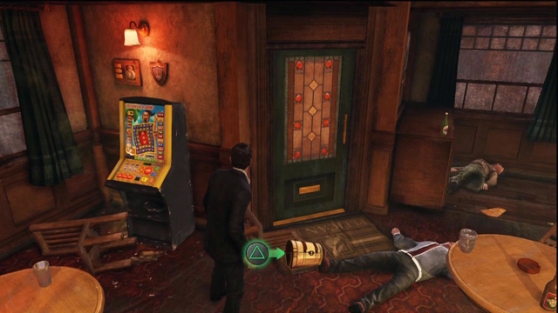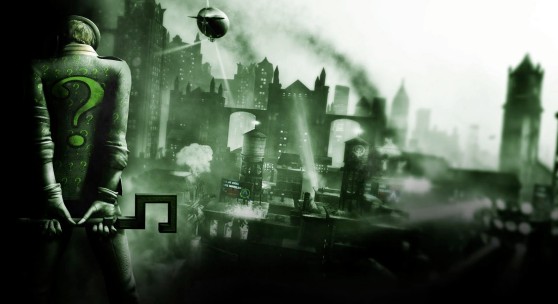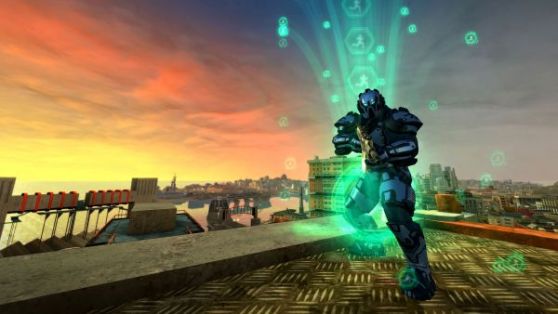Where, oh where, did we leave off? Something about collectibles, you say? Yes, yes, that sounds about right.
In the first part of this feature, I spoke broadly and theoretically about the nature of Easter Eggs and collectibles, with an emphasis on the latter. Collectibles have become a huge part of gaming and it seems, more often than not, every game has its own spin on the superfluous but popular feature. This time around, I would like to dissect collectibles as they appear in five games from the last couple years. Here goes.
Uncharted 3: Nooks, Crannies, and Buried Treasure
All three Uncharted games feature treasure. This is not the pocketbook enhancing treasure we know from reality but tiny digital keepsakes that players and Nathan Drake can gather up and keep as reminders of their former adventures. After all, what’s an adventure without something to remember it by?
The core experience of treasure within Uncharted 3 remains the same as its initial implementation in Uncharted: Drake’s Fortune. As Drake cuts his way through the dense forests, snow-covered ruins, and wrecked shipyards of the trilogy, players discover hundreds of trinkets (one hundred in Uncharted 3, to be exact), ranging from the banal ‘Antique Silver Box’ to the less banal ‘Ancient Alabaster Ibex.’ The collection reads like a catalogue of items Indiana Jones’ thought were too lame for his own collection. Unlike the infamous Fertility Idol from Raiders of the Lost Ark, these articles have no interesting back story. Drake’s attainment of collectibles rarely elicits anything more than a brief moment spent staring at the object. Sorry, no giant rolling boulders to chase after you upon acquisition.
 I can’t express affinity towards the series’ collectibles as a whole, but at least Uncharted 2 coupled these items with cash to spend on other in-game unlockables. That decision demonstrates that Naughty Dog sought to enhance a previously limited feature. Why then do we revert back to worthless collectibles in Uncharted 3? Developers can negate items’ uselessness by attaching additional value, like I just mentioned, or they can compact it with tangential decisions, such as placement within the world. In Uncharted 3, these already empty objects appear in obvious spaces, making their collection even more dull. Spot a dead-end alleyway? Surely there’s a collectible down there. The thrill of seeking out collectibles is absent as is the thrill of finding them. It’s a lacking system at best. If you were to complete remove collectibles from Nathan Drake’s adventures, gameplay would remain identical and story the same. Yes, they play up a sense for the character, but they don’t supplement the experience.
I can’t express affinity towards the series’ collectibles as a whole, but at least Uncharted 2 coupled these items with cash to spend on other in-game unlockables. That decision demonstrates that Naughty Dog sought to enhance a previously limited feature. Why then do we revert back to worthless collectibles in Uncharted 3? Developers can negate items’ uselessness by attaching additional value, like I just mentioned, or they can compact it with tangential decisions, such as placement within the world. In Uncharted 3, these already empty objects appear in obvious spaces, making their collection even more dull. Spot a dead-end alleyway? Surely there’s a collectible down there. The thrill of seeking out collectibles is absent as is the thrill of finding them. It’s a lacking system at best. If you were to complete remove collectibles from Nathan Drake’s adventures, gameplay would remain identical and story the same. Yes, they play up a sense for the character, but they don’t supplement the experience.
Crackdown: An Economy of Orbs
Crackdown features a unique form of collectibles, which may not even properly fit within the definition I set forth. Agility orbs and hidden orbs litter the city. On top of buildings, within alleyways, and even underneath the streets in some cases; these little glowing circles of light are the life blood of Crackdown. As a member of the future police-analogue, The Agency, players must leap, climb, and drive their way across Pacific City, taking out the criminal garbage on the way. The game hinges on player development in a variety of skills. Agility, strength, firearms, explosives, and driving; these are the things you need to clean up the city. Experience in strength, firearms, explosives, and driving derives from utility. The more you use them, in the measurable terms set forth by the game, the more robust your agent becomes. These skills are nice, but the main draw is agility. The game replicates like none before it the sensation of ascending skyscrapers with your bare hands. In order to cultivate this core function and lacking in enforceable terms beyond hopping constantly, developers created collectible orbs that bolster player’s natural agility.
Players scour the city in search of the game’s whopping 500 Agility Orbs and 200 Hidden Orbs. The former improves players agility skill and the latter randomly boosts the others. These numbers would prove insurmountable in nearly any other game, but developer Real Time Worlds built these orbs into the core gameplay. If I were to reduce the game’s features down to its most essential, I would mention unique locomotion, action, and collection. The game’s missions leave much to be desired. Instead, free roaming takes the place of elaborate objectives. The Agility Orbs reinforce Real Time Worlds’ thesis, which revolves around making the most badass super human, capable of climbing any building in Pacific City. Sure, orbs are identical and offer no insight into the world of Crackdown, but they direct players towards meaningful goals in an otherwise anarchic world and improve players’ experience of the game by enhancing their avatar.
The Darkness II: Parallel Narratives
[Warning: This passage features spoilers from the game’s campaign. Read at your own risk.]
The first Darkness featured unique but ultimately worthless collectibles. Phone numbers allowed Jackie to place calls to random people and businesses around New York, which often provided quirky dialogue but little else. In The Darkness II, Digital Extremes (who did not develop the first game) decide to make meaningful this near obligatory feature. As Jackie explores Digital Extremes’ colorful but grim New York City, he discovers relics. These items range from The Abysmal Maw to the Reliquary of the Blessed. The names may seem abstract, but most are tied directly to theology and history. As such, they provide revisionist accounts of specific Bible stories or historical events. Early on, I enjoyed the short passages–which are also narrated by Johnny Powell–for what they were: simple twists on existing narratives. If you are at all familiar with major events in history as well as the Bible, you’ll probably get a kick of seeing how the Darkness has infected the world since its beginnings.
As the game progressed and I collected more of the 29 total collectibles, I began to notice continuity within the stories. The narrative of The Darkness and its foil, The Angelus, became more central throughout later relics’ descriptions and I found myself becoming as interested in the game’s mythology as Jackie’s tragic tale. Upon finishing the game, I set my controller down and watched the credits roll. Rather than returning to the main menu, The Darkness II rewards patient gamers like myself with one final scene that pays off on the game’s micro narrative. The Angelus’ reappearance may be just another cutscene for casual players but for those followed the tangential story by collecting relics, it’s a wonderful and even heartbreaking shock.
The caveat to The Darkness II’s approach is whether or not players care about the additional content. Through collectibles, the game essentially tasks gamers with studying. The Angelus is mentioned in passing during the campaign, meaning only those paying no attention to the story should be confused, but the impact of its appearance is dulled without the collectibles. In hopes of more participation, Digital Extremes doesn’t make collection difficult and each anecdote proves entertaining in its own right. There’s a very fine line between providing supplement and withholding or improperly distributing information. The Darkness II uses collectibles to expertly walk this line.
Gears of War: The War Effort
Gears of War as a series employs collectibles in a traditional but effective manner. The first game featured dog tags from fallen comrades. These were your run-of-the-mill secret items and they proffered no significant bounty. As such, I invested little time into discovering them. As a utilitarian, I often struggle to complete tasks or actions I view as having little purpose. In my opinion, mindless conglomeration is not motivation enough to waste hours scouring digital landscapes. Luckily, Epic Games improved the collectibles significantly for the later two installments of the franchise.
 In Gears of War 2 and 3, Epic continued to implement dog tags, but supplemented the feature with more memorable collectibles, artifacts. As Epic shifted its focus towards delivering a stronger narrative and a richer world, they adapted collectibles to do the same. Players can discover personal notes, journal entries, memorials, and torn bits of newspaper, among other items. As you collect these items, they overtake the screen and allow players to inspect them up close and read more about them. Through gathering these artifacts, players gain a stronger sense of the Gears of War universe. Epic embellishes characters, details skirmishes, and paints a world in its death throes.
In Gears of War 2 and 3, Epic continued to implement dog tags, but supplemented the feature with more memorable collectibles, artifacts. As Epic shifted its focus towards delivering a stronger narrative and a richer world, they adapted collectibles to do the same. Players can discover personal notes, journal entries, memorials, and torn bits of newspaper, among other items. As you collect these items, they overtake the screen and allow players to inspect them up close and read more about them. Through gathering these artifacts, players gain a stronger sense of the Gears of War universe. Epic embellishes characters, details skirmishes, and paints a world in its death throes.
While Gears of War‘s collectibles are not necessary to player’s enjoyment of the franchise, they do enhance it through the development of context. In order for most audiences to engage in most works of fiction, there must be something at stake. Whether it’s the integrity of an individual’s identity or even just acquiring an item, many stories benefit from contextualizing their conflicts. In this way, artifacts in Gears of War 2 and 3 help to flesh out a world in which players can invest. In the future, I hope we can relay this information via gameplay means, but for now, these collectibles do a fine job supporting Epic’s vision of Sera for interested players.
Batman: Arkham Asylum: A Riddle Wrapped In An Enigma
[At this time, I have not played Batman: Arkham City, so this is based solely off the first game, though the system remains mostly the same but with some significant additions. Also, mild spoilers ahead.]
Each of the previous examples (loosely) demonstrated the four different types of collectibles I laid out in my previous piece. Uncharted 3 (ineffectively) portrays exploration collectibles, Crackdown handles economic collectibles, The Darkness blends narrative collectibles with collectibles of the world, and Gears of War sticks mostly to collectibles of the world. These definitions are loose and based upon (my own) theory, meaning that they often show up differently in reality, or, in this case, simulation. While I admire three of the four examples, none compare to the all-encompassing approach of Batman: Arkham Asylum.
As The Dark Knight, players can explore every inch of a wonderfully realized Arkham Asylum. The infamous mental hospital appears in Arkham Asylum as a segmented, quasi-open world. Within this space, Batman is free, and encouraged, to explore every inch of this detailed environment. Amidst its hidden caverns and tight air ducts lie 250 collectibles. This tall order has the potential to turn off players, but the variety of collectibles as well as their unique purposes convinced me to nab each and every last one.
Riddler Trophies and Joker Teeth provide exploration collectibles. They exist to be found or destroyed and little else. Developer Rocksteady Studios bolster these ranks with two different varieties of tape recordings. One set reveals patient interviews with Arkham’s most demented while another lays out the dark history of Arkham Island through the words of its sadistic founder as well as its current warden. Both tape recordings gift players with exposition. The former develop the villains Batman will come to face over the course of the game and the latter add depth to the game’s fantastic sense of place. Finally, there are literal riddles. Hints direct players to discover visual cues within the environment, often tied back to details referencing Batman’s long legacy.
Arkham Asylum‘s collectibles enhance the game’s world and narrative and, furthermore, they are inspired by the player character and the ways in which he would potentially interact with any environment he encountered. Sure, Batman fights supervillains and uses interesting gadgets, but he is a detective at heart. Batman relies on his keen senses outside of combat, which translates to the game’s Detective Mode. The visual overlay highlights enemies and objects of interest within the world, but players still must use their own wits to discover the game’s numerous collectibles. Rocksteady aims to convey the feeling of ‘being Batman,’ and luckily for players, they apply this goal across every facet of the game. Arkham Asylum‘s collectibles succeed where others’ do not by approaching them from both gameplay and narrative perspectives and offering enough variety to keep the search entertaining.
Conclusion…For Real
Most of the collectibles in the previously mentioned games have one major issue: they’re optional. And until every game features collectibles, they will remain as such. I’m not advocating the use of collectibles in all games. On the contrary, games should feature collectibles only when they support gameplay or narrative in ways other aspects of the design cannot. Just because they’re not essential doesn’t mean they cannot be important. Like DLC, extra content–in this case, in the form of collectibles–can be a gift to voracious, curious gamers like myself but it can also be a colossal waste of time. For example, I acquired half of Uncharted 3‘s hidden treasures, and only because they were lazily placed about levels, but in Arkham Asylum, I collected every single Riddler trophy. Collectibles’ success depends upon investment in the game as well as their implementation and ultimate reward. Developers looking for success should first put effort into their collectibles and then cultivate those player motivations. Without them, all you have are valueless digital items in a vast digital space.



